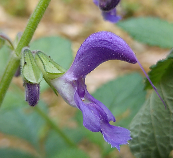×
![]()
丹參
Salvia miltiorrhiza Bunge
別名:赤參、逐烏、山參、鬱蟬草、木羊乳、奔馬草、血參、血參根、野蘇子根、大紅袍、壬參、紅參、紅根、紅根赤參、紅丹參、赤丹參、紫參、紫丹參、五風花、陰行草、活血根、大葉活血丹
形態:
多年生直立草本;根肥厚,肉質疏生支根。莖直立,四稜形,密被柔毛。葉對生,奇數羽狀複葉,具葉柄,小葉 3-7,橢圓狀卵圓形,先端尖,基部鈍,鋸齒緣,兩面被疏柔毛。花序頂生,多花排成總狀花序,花序軸被柔毛與腺毛,苞片披針形,花萼鐘形,帶紫色,被柔毛與腺毛,2 裂;花冠紫藍色合生上端開裂成唇形,上唇先端 2 淺裂、下唇 3 裂、中裂片較寬大,先端鋸齒緣;可孕雄蕊 2 枚,生於冠筒喉部的前方,花藥 2 室,藥隔延長成丁字型,上臂頂端藥室著生有花粉,下端花藥特化成棒狀,位於花冠裂縫處;花粉橢圓形,扁平,6 溝,表面具網狀紋飾及穿孔,小堅果黑色,橢圓形。
典籍記載之相關效用:
丹參的根,味苦性微寒,有活血化瘀、安神寧心、調經止痛、涼血消腫之效,主治月經不調、痛經、經閉、產後瘀滯腹痛、心腹疼痛、癥瘕積聚、熱痺腫痛、跌打損傷、煩躁不安、心煩失眠等。《台灣藥用植物資源名錄 399》
丹參《神農本草經》為丹參和甘西鼠尾草的根,味苦性微寒,有活血祛瘀、調經止痛、養血安神、涼血消癰之效,主治婦女月經不調、痛經、經閉、產後瘀滯腹痛、心腹疼痛、癥瘕積聚、熱痹腫痛、跌打損傷、熱入營血、煩躁不安、心煩失眠、癰瘡腫毒等。《中華本草》
藥理研究:
丹參的藥理活性很多,本所研究人員參與的研究如下:代謝酶調節作用 [1★-3★]:在體外實驗證實丹參酮 IIA (tanshinone IIA) 具細胞色素 CYP1A2 抑制活性;在 C57BL/6J 小鼠實驗則發現丹參酮 IIA 誘導 CYP1A;進一步證明丹參提取物可以誘導細胞色素 P450 依賴的單氧酶。保肝和抗纖維化作用 [4★-7★]:實驗證實丹酚酸A (salvianolic acid A) 可藉由凋亡作用抑制 PDGF-誘發的肝星狀細胞增殖。也證實丹酚酸B (salvianolic acid B) 可改善肝細胞氧化損傷和消除活性氧積累,及衰減肝星狀細胞活化;結果表明丹酚酸B具潛在保肝和抗纖維化作用。也實驗表明丹參、川芎、甘草的混合提取對N-亞硝基二甲胺 (DMN)-誘導大鼠肝纖維化模式具有抗纖維化作用。也證實丹參成分的丹參酮 IIA 也會降低 LPS 誘導肝星狀細胞活化。抑制巨噬細胞遷移 [8★-9★]:實驗證實丹參的隱丹參酮 (cryptotanshinone) 可藉由抑制F-肌動蛋白聚合和絲狀偽足外伸而阻礙補體5a (C5a) 及MIP-la所誘導的巨噬細胞遷移。抗白血病活性 [10★]:在 CCRF-CEM 類淋巴母細胞株及其多重抗藥性細胞株 CEM/ADR5000 的實驗發現,丹參的迷迭香酸 (rosmarinic acid) 能誘導細胞凋亡和壞死,能使細胞週期停滯而抑制生長。
化學成分研究:
★ 從丹參分離出 5 個含氮化合物 neosalvianen, salvianen, salvianan, salviadione, 5-(methoxymethyl)-1H-pyrrole-2-carbaldehyde;其中 salvianen 對三種癌細胞株具細胞毒性 [11★]。★ 從丹參根的乙醇提取中分離到 salvianonol, salviamone, 2α-acetoxysugiol, palmitoyl arucadiol, (E)-4-[5-(hydroxylmethyl)furan-2-yl]but-3-en- 2-one, dihydroisotanshinone I, danshenxinkun A & B, 1,2-dihydrotanshinone I, abietic acid 等芳香族成分 [12★]。
參考文獻:
- ★Ueng, Y. F., Kuo, Y. H., Peng, H. C., Chen, T. L., Jan, W. C., Peter Guengerich, F. and Lin, Y. L. (2003) Diterpene quinone tanshinone IIA selectively inhibits mouse and human cytochrome p4501A2, Xenobiotica, 33 (6): 603-13
- ★Ueng, Y. F., Kuo, Y. H., Wang, S. Y., Lin, Y. L. and Chen, C. F. (2004) Induction of CYP1A by a diterpene quinone tanshinone IIA isolated from a medicinal herb Salvia miltiorrhiza in C57BL/6J but not in DBA/2J mice, Life Sci., 74 (7): 885-96
- ★Kuo, Y. H., Lin, Y. L., Don, M. J., Chen, R. M. and Ueng, Y. F. (2006) Induction of cytochrome P450-dependent monooxygenase by extracts of the medicinal herb Salvia miltiorrhiza, J. Pharm. Pharmacol., 58 (4): 521-7
- ★Lin, Y. L., Lee, T. F., Huang, Y. J. and Huang, Y. T. (2006) Antiproliferative effect of salvianolic acid A on rat hepatic stellate cells, J. Pharm. Pharmacol., 58 (7): 933-9
- ★Lin, Y. L., Wu, C. H., Luo, M. H., Huang, Y. J., Wang, C. N., Shiao, M. S. and Huang, Y. T. (2006) In vitro protective effects of salvianolic acid B on primary hepatocytes and hepatic stellate cells, J. Ethnopharmacol., 105 (1-2): 215-22
- ★Lin, Y. L., Hsu, Y. C., Chiu, Y. T. and Huang, Y. T. (2008) Antifibrotic effects of a herbal combination regimen on hepatic fibrotic rats, Phytother. Res., 22 (1): 69-76
- ★Liu, Y. W. and Huang, Y. T. (2014) Inhibitory effect of tanshinone IIA on rat hepatic stellate cells, PLoS One, 9 (7): e103229
- ★Chiou, W. F. and Don, M. J. (2007) Cryptotanshinone inhibits macrophage migration by impeding F-actin polymerization and filopodia extension, Life Sci., 81 (2): 109-14
- ★Don, M. J., Liao, J. F., Lin, L. Y. and Chiou, W. F. (2007) Cryptotanshinone inhibits chemotactic migration in macrophages through negative regulation of the PI3K signaling pathway, Br. J. Pharmacol., 151 (5): 638-46
- ★Wu, C. F., Hong, C., Klauck, S. M., Lin, Y. L. and Efferth, T. (2015) Molecular mechanisms of rosmarinic acid from Salvia miltiorrhiza in acute lymphoblastic leukemia cells, J. Ethnopharmacol., 176: 55-68
- ★Don, M. J., Shen, C. C., Lin, Y. L., Syu, W. J., Ding, Y. H. and Sun, C. M. (2005) Nitrogen-containing compounds from Salvia miltiorrhiza, J. Nat. Prod., 68 (7): 1066-70
- ★Don, M. J., Shen, C. C., Syu, W. J., Ding, Y. H. and Sun, C. M. (2006) Cytotoxic and aromatic constituents from Salvia miltiorrhiza, Phytochemistry, 67 (5): 497-503
|
|
 1 /
2 1 /
2
|


 1 /
2
1 /
2
